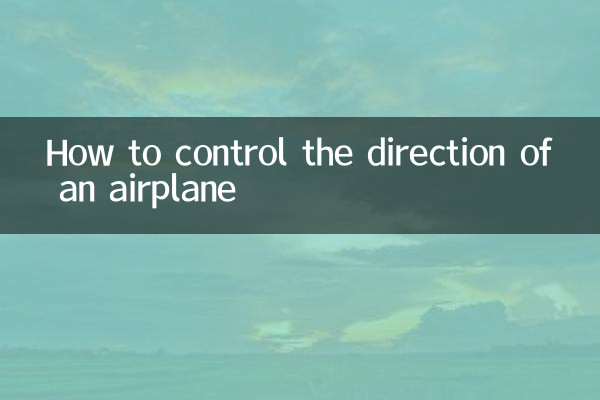How to control the direction of an airplane
When an aircraft is flying in the air, controlling the direction is a complex and precise process. The pilot controls the various control surfaces of the aircraft and adjusts the thrust of the engine to achieve the steering, climb and descent of the aircraft. This article will introduce in detail how the aircraft controls the direction, and attach relevant data tables to help readers better understand this process.
1. Basic principles of aircraft control direction

The directional control of an aircraft mainly relies on three basic control surfaces: ailerons, elevators and rudder. These control surfaces change the direction of the airflow, thereby generating a moment that causes the aircraft to rotate around its axis and adjust its direction.
| control surface | effect | axis of control |
|---|---|---|
| aileron | Control the roll of the aircraft (tilt left and right) | Longitudinal axis (axis from nose to tail) |
| elevator | Control the pitch of the aircraft (tilt up and down) | Transverse axis (the axis from one side of the wing to the other) |
| rudder | Control the yaw of the aircraft (turn left and right) | Vertical axis (axis perpendicular to the ground) |
2. Detailed process of aircraft direction control
1.Roll control (ailerons): When the pilot presses the control stick to the left, the left aileron deflects upward and the right aileron deflects downward. The lift on the left wing decreases and the lift on the right wing increases, causing the aircraft to tilt to the left. vice versa.
2.Pitch control (elevator): The pilot pulls the control stick backward to deflect the elevator upward. The lift on the tail increases and the nose of the aircraft lifts upward. Pushing the control stick forward causes the elevator to deflect downward and the nose of the aircraft to dive downward.
3.Yaw control (rudder): The rudder is located on the vertical tail, and the pilot controls its deflection by stepping on the rudder pedals. Press the pedal to the left, the rudder will deflect to the left, and the airflow will generate a rightward force on the tail, causing the nose of the aircraft to deflect to the left. vice versa.
3. Auxiliary system for aircraft direction control
Modern aircraft are usually equipped with a variety of auxiliary systems to enhance the accuracy and safety of directional control. The following are several common auxiliary systems:
| Auxiliary system | Function | Application model example |
|---|---|---|
| autopilot | Automatically control the flight attitude and direction of the aircraft | Boeing 787, Airbus A350 |
| fly-by-wire system | Transmit control instructions through electronic signals to improve response speed | Airbus A320, Boeing 777 |
| thrust vector control | Enhance maneuverability by adjusting engine nozzle direction | F-22 fighter, Su-35 fighter |
4. Typical cases of aircraft direction control
1.Turning of civil aviation aircraft: Civilian aircraft usually need to coordinate the use of ailerons and rudder when turning. For example, when turning left, the pilot will press the joystick to the left (aileron control) while pressing the rudder pedal slightly to the left to maintain the balance of the aircraft.
2.Fighter maneuvers: When fighter jets perform difficult maneuvers, they often need to use ailerons, elevators, rudders and thrust vector control at the same time. For example, in the Cobra maneuver, the pilot needs to quickly pull the stick to deflect the elevator significantly while adjusting the thrust vector to maintain the stability of the aircraft.
5. Future development trends of aircraft direction control
With the advancement of science and technology, aircraft direction control technology is also constantly developing. More intelligent control systems may appear in the future, such as:
1.Artificial intelligence assisted flight: Through machine learning algorithms, the aircraft can automatically optimize flight path and direction control, reducing the pilot's workload.
2.New material control surface: The control surface is made of lightweight, high-strength new materials to improve control efficiency and response speed.
3.Distributed propulsion system: Multiple small engines or motors independently control thrust to achieve more flexible direction adjustment.
Through the above analysis, we can see that the direction control of the aircraft is a complex process in which multiple systems work together. Whether it is a civil aviation aircraft or a military fighter aircraft, precise design and skilled operation are required to achieve safe and efficient flight.

check the details

check the details